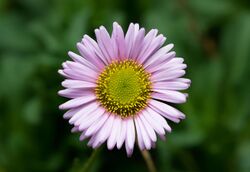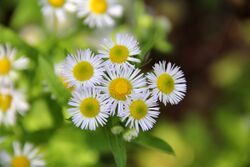Biology:Erigeron
| Fleabane | |
|---|---|

| |
| Erigeron glaucus, seaside daisy | |
| Scientific classification | |
| Kingdom: | Plantae |
| Clade: | Tracheophytes |
| Clade: | Angiosperms |
| Clade: | Eudicots |
| Clade: | Asterids |
| Order: | Asterales |
| Family: | Asteraceae |
| Subfamily: | Asteroideae |
| Tribe: | Astereae |
| Subtribe: | Conyzinae |
| Genus: | Erigeron L.[1] |
| Diversity[2] | |
| Around 460 species | |
| Synonyms[3] | |
|
Synonymy
| |
Erigeron (/ɪˈrɪdʒərɒn/)[4] is a large genus of plants in the composite family (Asteraceae).[5] It is placed in the tribe Astereae and is closely related to the Old World asters (Aster) and the true daisies (Bellis). The genus has a cosmopolitan distribution, but the highest diversity occurs in North America.[5][6][7][8][9]
Etymology


Its English name, fleabane, is shared with related plants in several other genera. It appears to be derived from a belief that the dried plants repelled fleas[10] or that the plants were poisonous to fleas.[11] The generic name Erigeron is derived from the Ancient Greek words ἦρι (êri) "early in the morning" and γέρων (gérōn) "old man", a reference to the appearance of the white hairs of the fruit soon after flowering[12] or possibly alluding to the early appearance of the seed heads.[13] The noun γέρων is masculine,[14] so that specific epithets should have masculine endings (e.g. glaucus) to agree with it. However, authors have incorrectly used neuter endings (e.g. glaucum), because the ending -on resembles the ending of Ancient Greek neuter second declension nouns, as Augustin Pyramus de Candolle did in his 1836 account of the genus.[15]
Description
The species may be annuals, biennials, or perennials. They are well-branched with erect stems, characterized by their numerous white, lavender, or pink ray flowers and yellow disc flowers. Some members of this group have no ray flowers. The pappus (=modified calyx, forming a crown) is shorter than in Aster and consists of bristles. The ray florets are narrower than in Aster but are longer than the involucre (=whorled bracts).
Cultivation
Many species are used as ornamental plants, with numerous named cultivars such as 'Wayne Roderick', 'Charity', 'Foersters Liebling', and 'Dunkelste aller' ("The darkest of all" with semi-double, deep-violet flower heads).[16][17]
Ecology
Erigeron species are used as food plants by the larvae of some Lepidoptera species including Bucculatrix angustata, Coleophora squamosella (which feeds exclusively on E. acris), Schinia intermontana, Schinia obscurata (both of which also feed exclusively on Erigeron), Schinia sexata (which feeds exclusively on E. glabellus) and Schinia villosa. Above-ground biomass of Erigeron in montane meadows decreases with decreased water availability/increased temperatures.[18]
Selected species
(As of 2020) Royal Botanic Gardens, Kew's Plants of the World Online lists around 460 species of plants in the genus Erigeron.[2] Selected species include:
The following names are not accepted (As of 2020) in Royal Botanic Gardens, Kew's Plants of the World Online database:[2]
- Erigeron acer – blue fleabane
- Erigeron austiniae
- Erigeron corymbosus – long-leaf fleabane
- Erigeron greenei
- Erigeron hultenii – Hulten's fleabane
- Erigeron irazuensis
References
- ↑ Linnaeus, Carl (1753) (in la). Species plantarum: exhibentes plantas rite cognitas ad genera relatas, cum differentiis specificis, nominibus trivialibus, synonymis selectis, locis natalibus, secundum systema sexuale digestas. 2. Berlin: Junk. p. 863. https://www.biodiversitylibrary.org/page/358881#page/305/mode/1up.
- ↑ 2.0 2.1 2.2 "Erigeron L.". Royal Botanic Gardens, Kew. https://powo.science.kew.org/taxon/urn:lsid:ipni.org:names:326342-2.
- ↑ Flann, C (ed) 2009+ Global Compositae Checklist
- ↑ Sunset Western Garden Book (6th ed.). Sunset Books. 1995. pp. 606–607. ISBN 978-0-376-03850-0.
- ↑ 5.0 5.1 Nesom, Guy L (2006), "Erigeron", Flora of North America, 20, New York & Oxford: Oxford University Press, p. 256, http://www.efloras.org/florataxon.aspx?flora_id=1&taxon_id=112000
- ↑ Linnaeus, Carl von. 1753. Species Plantarum 2: 863-865 in Latin
- ↑ Tropicos, Erigeron L.
- ↑ RHS A-Z encyclopedia of garden plants. United Kingdom: Dorling Kindersley. 2008. p. 1136. ISBN 978-1-4053-3296-5.
- ↑ The Plant List, search for Erigeron
- ↑ Frances Perry wrote in Collins Guide to Border Plants (2nd edition, 1956) p.146 that it was reputed to repel insects but that the name referred to a tropical species which has a particularly strong odour
- ↑ see Oxford English Dictionary under 'Flea-bane' and under 'Bane' para 2.b. The earliest quotation cited in the O.E.D. is dated 1813 when Humphry Davy in Elements of Agricultural Chemistry stated that the fleabane of Canada had only recently been found in Europe
- ↑ Hyam, R.; Pankhurst, R.J. (1995). Plants and their names: a concise dictionary. Oxford: Oxford University Press. p. 178. ISBN 978-0-19-866189-4.
- ↑ Frances Perry: Collins Guide to Border Plants 2nd edition (1956) p.145
- ↑ γέρων in Liddell, Henry George; Scott, Robert (1940) A Greek–English Lexicon, revised and augmented throughout by Jones, Sir Henry Stuart, with the assistance of McKenzie, Roderick. Oxford: Clarendon Press. In the Perseus Digital Library, Tufts University.
- ↑ de Candolle, Augustin Pyramus (1836). "Erigeron". Prodromus systematis naturalis regni vegetabilis. pp. 283–296. https://www.biodiversitylibrary.org/page/151718. Retrieved 2014-02-11.
- ↑ Perry, Leonard. "Erigeron". http://pss.uvm.edu/pss123/pererige.html.
- ↑ "RHS Plant Selector - Erigeron 'Dunkelste Aller'". http://apps.rhs.org.uk/plantselector/plant?plantid=5180.
- ↑ de Valpine, Perry; Harte, John (March 2001). [0637:PRTEWI2.0.CO;2 "Plant Responses to Experimental Warming in a Montane Meadow"] (in en). Ecology 82 (3): 637–648. doi:10.1890/0012-9658(2001)082[0637:PRTEWI2.0.CO;2]. ISSN 0012-9658. http://doi.wiley.com/10.1890/0012-9658(2001)082[0637:PRTEWI]2.0.CO;2.
Wikidata ☰ Q745253 entry
 |

